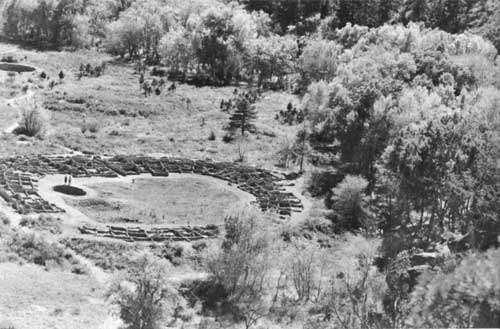|
BANDELIER National Monument |
 |

Tyuonyi Ruin, with the Big Kiva at left rear, and
the trees
of the campground at top of the picture.
Principal Ruins of the National Monument
TYUONYI. On the floor of Frijoles Canyon, a little upstream from the headquarters museum, is Tyuonyi, the chief building of the area, and one of the most impressive pueblo ruins in the Rio Grande drainage. Situated on a level bench of open ground, perhaps 100 feet from the Rito and 15 feet above the water, Tyuonyi at one time contained over 400 rooms, to a height of 3 stories in part. Its modern aspect is greatly reduced in height; although excavated, no walls have been restored, so that only the ground floor is still evident, with outer and inner walls standing to a height of 4 or 5 feet throughout.
To appreciate the size and lay-out of Tyuonyi, you should climb the nearby slope until a bird's-eye view reveals the entire ground plan of the huge circle. From above, more than 250 rooms can be counted, placed in concentric rows around a central plaza. The most massive part of the circle is 8 rooms across, narrowing to 4 rooms in breadth at the brook side. The 2- and 3-story parts of the building, as computed from the height of the original rubble, were at the massive eastern side.
One of the most striking features of Tyuonyi is the entrance passage through the eastern part of the circle. This passage was apparently the only access to the central plaza, other than by ladders across the rooftops. An arrangement of this sort, of course, suggests a concern for defensive strength on the part of Tyuonyi's builders; certainly the circle of windowless, doorless walls would have presented a problem to attackers, once the ladders were drawn up and the single passageway blocked.
It is believed that a good part of the first-floor rooms of Tyuonyi were storage chambers of the type previously discussed. This belief is borne out by the fact that during excavation many of these rooms were found to be without fireplaces, a condition which would have made such rooms unlivable in cold weather. The problem of smoke clearance was very serious in the larger pueblos, since the builders had no knowledge of modern fireplaces with chimney flues; hence the building of fires on the lower floors of multistory buildings worked a hardship on upstairs occupants and must have been avoided whenever possible.
The age of the Tyuonyi construction has been fairly well established by the tree-ring method of dating, so widely and successfully used by archeologists in the Southwest. Ceiling-beam fragments recovered from various rooms give dates between A. D. 1383 and 1466. This general period seems to have been a time of much building in Frijoles Canyon; a score of tree-ring dates from Rainbow House ruin, which is down the canyon a half mile, fall in the early and middle 1400's. Perhaps the last construction anywhere in Frijoles Canyon occurred close to A. D. 1500, with a peak of population reached near that time or shortly thereafter.

|

|
|
Last Modified: Sat, Jan 6 2001 10:00:00 am PDT |


